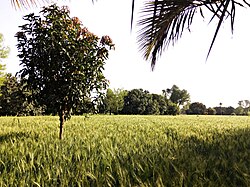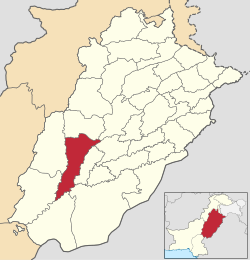This is an old revision of this page, as edited by 2a03:2880:31ff:8::face:b00c (talk) at 17:04, 25 September 2022 (→Forests: To give right information.). The present address (URL) is a permanent link to this revision, which may differ significantly from the current revision.
Revision as of 17:04, 25 September 2022 by 2a03:2880:31ff:8::face:b00c (talk) (→Forests: To give right information.)(diff) ← Previous revision | Latest revision (diff) | Newer revision → (diff)District of Punjab in Pakistan
| Muzaffargarh District ضِلع مُظفّرگڑھ | |
|---|---|
| District of Punjab | |
  Top: Tomb of Sheikh Sadan Top: Tomb of Sheikh SadanBottom: Fields in Muzaffargarh district | |
 District Government logo District Government logo | |
 Map of Muzaffargarh District highlighted in red Map of Muzaffargarh District highlighted in red | |
| Coordinates: 30°4′10″N 71°11′39″E / 30.06944°N 71.19417°E / 30.06944; 71.19417 | |
| Country | |
| Province | |
| Division | Dera Ghazi Khan |
| Headquarters | Muzaffargarh |
| Government | |
| • Type | District Government |
| • Deputy Commissioner | Amjad Shoaib Tareen |
| • District Police Officer | Hassan Iqbal |
| • District Health Officer | N/A |
| Area | |
| • Total | 8,249 km (3,185 sq mi) |
| Population | |
| • Total | 4,328,549 |
| • Density | 520/km (1,400/sq mi) |
| Time zone | UTC+5 (PST) |
| Number of Tehsils | 4 |
Muzaffargarh District (Template:Lang-ur) is a district of the Punjab province of Pakistan. Its capital is Muzaffargarh city. It lies on the bank of the Chenab River.
Administration
The district is administratively divided into the following five tehsils (subdivisions), which contain a total of 93 Union Councils:
| Tehsil | No. of Unions |
|---|---|
| Alipur | 14 |
| Chowk Sarwar Shaheed | 3 |
| Jatoi | 16 |
| Kot Addu | 33 |
| Muzaffargarh | 35 |
| Total | 101 |
Demographics
At the time of the 2017 census the district had a population of 4,328,549, of which 2,223,085 were males and 2,105,145 females. Rural population is 3,630,138 while the urban population is 698,411. The literacy rate was 47.11%.
Religion
As per the 2017 census, Muslims made up almost the entire population with 99.78%.
| Religion | Population (1941) | Percentage (1941) |
|---|---|---|
| Islam |
616,074 | 86.42% |
| Hinduism |
90,643 | 12.72% |
| Sikhism |
5,882 | 0.83% |
| Christianity |
218 | 0.03% |
| Others | 32 | 0% |
| Total Population | 712,849 | 100% |
Language
At the time of the 2017 census, 88.23% of the population spoke Saraiki, 5.66% Punjabi, 4.51% Urdu and 1.07% Pashto as their first language.
Ethnicity
The major ethnic group are the Saraiki-speaking Jatt forming the majority, with Saraiki-speaking Gujjar, Baloch, Rajputs and Pathans groups in minority.
History
In 997 CE, Sultan Mahmud Ghaznavi, took over the Ghaznavid dynasty empire established by his father, Sultan Sebuktegin, In 1005 he conquered the Shahis in Kabul in 1005, and followed it by the conquests of Punjab region. The Delhi Sultanate and later Mughal Empire ruled the region. The Punjab region became predominantly Muslim due to missionary Sufi saints whose dargahs dot the landscape of Punjab region.
Muzaffargarh region became a part of the Muslim Sultanate of Delhi when the Persian noble Sultan Shahab-ud-Din Muhammad Ghauri conquered Punjab in 1185. Faisalabad slowly developed as medieval town and many Muslim Sufi missionaries converted the local population to Islam. During the Mughal period population increased and land under cultivation increased. After the decline of the Mughal Empire, the Sikh Empire invaded and occupied Muzaffargarh region. The Muslims faced restrictions during the Sikh rule. Between 1765 and 1846 Muzaffargarh was occupied by the Sikhs. Two main battles between British and Sikh armies were fought in this district on 22 February 1849 the British declare victory in Punjab.
Muzaffargarh was founded in 1794 by the Governor of Multan Nawab Muzaffar Khan. The Meaning of Muzaffargarh is "Fort of Muzaffar" because the old town lies inside the walls of a fort built by Nawab Muzaffar Khan of Multan. Prior to that the place was known by a shop called "Musan Hatti", on the road leading from Multan to Dera Ghazi Khan. In 1861 it became the headquarters of Muzaffargarh District.
After the independence of Pakistan in 1947, the minority Hindus and Sikhs migrated to India while the Muslim refugees from India settled in the Muzaffargarh District. Muslim refugees from East Punjab, Haryana, Jammu started arriving and crossed the border into Pakistan; many were given land in Muzaffargarh District to settle.
Muzaffargarh spreads over an area of 8,249 km2 and forms a strip between the Chenab River on its east and Indus River on its west, which pass along the Eastern and Western boundaries respectively of the district and a triangle at Alipur tehsil of the district. The district is bounded on the north by district Layyah, on the south by Bahawalpur and Rahimyar Khan districts across the river Chenab. Districts Multan and Khanewal are on the eastern side of district Muzaffargarh, across the river Chenab. District Jhang touches it on the northeast. Dera Gahzi Khan and Rajanpur districts lie on the western side across the river Indus. It is one of oldest districts of Punjab. According to the 1998 census of Pakistan, the population of the district was 2,635,903, of which 12.75% were urban. Muzaffargarh is one of oldest districts of Punjab.
Muzaffargarh was especially hard hit by the 2010 Pakistan floods, given its position between the Chenab and Indus rivers It is spread over an area of 8,249 km. Muzaffargarh District lies in the strip between the rivers Chenab and Indus.
Geography and climate
| Muzaffargarh | ||||||||||||||||||||||||||||||||||||||||||||||||||||||||||||
|---|---|---|---|---|---|---|---|---|---|---|---|---|---|---|---|---|---|---|---|---|---|---|---|---|---|---|---|---|---|---|---|---|---|---|---|---|---|---|---|---|---|---|---|---|---|---|---|---|---|---|---|---|---|---|---|---|---|---|---|---|
| Climate chart (explanation) | ||||||||||||||||||||||||||||||||||||||||||||||||||||||||||||
| ||||||||||||||||||||||||||||||||||||||||||||||||||||||||||||
| ||||||||||||||||||||||||||||||||||||||||||||||||||||||||||||
The city of Muzaffargarh is located in southern Punjab province at almost the exact centre of Pakistan. The closest major city is Multan. The area around the city is a flat, alluvial plain and is ideal for agriculture, with many citrus and mango farms. There are many canals that cut across the Muzaffargarh District, providing water from nearby farms. This makes the land very fertile. However usually land close to the Chenab are usually flooded in the monsoon season.
Muzaffargarh features an arid climate with very hot summers and mild winters. The city witnesses some of the most extreme weather in the country. The highest recorded temperature is approximately 54 °C (129 °F), and the lowest recorded temperature is approximately −1 °C (30 °F). The average rainfall is roughly 127 millimetres (5.0 in). Dust storms are a common occurrence within the city.
The district's towns include Basti Malik Wala, Taliri, Mauza Bahadur Dawana, Dawana Bahadur Peer Rajan Bukhsh, Kot Addu, Khangarh and Hayat Nagar.
Education
Although Muzaffargarh is one of the oldest and largest districts of Pakistan by area and population, it still has only a single campus of Virtual University of Pakistan. The literacy rate is one of the lowest in the country. District Muzaffargarh has a total of 1,072 male and 1,009 female public sector schools. According to the School Education Department's data, a total of 5,023 male and 4,130 female teachers are employed in public school education sector of the district.
Forests
An area of 100,864 acres is forested in the district biggest among Lashari wala Forest. There is also linear plantation of 1250 A.V. mile the roads/rails/canals in the district. Trees grown in the area are kikar, shisham, millbury, eucalyptus, bamboo and coconut.
Economy
The economy of Muzaffargarh consists of agriculture, industry and services sectors. Muzaffargarh Fruits and vegetables market supply the local goods to the entire country. There are several industrial units there and among them PARCO oil refinery has great importance. The other's are shekho sugar mill, Fatima sugar mill,tandliyan wala sugar mill are important. Thalia jute mill also present here which is among the largest jute mills of Asia.
References
- "Administration of Muzaffargarh District". mgarh.com. Archived from the original on 24 December 2017. Retrieved 28 December 2017.
- "DPO Muzaffargarh District Police". www.mgarh.com. Archived from the original on 9 January 2018. Retrieved 28 December 2017.
- ^ "District Wise Results / Tables (Census - 2017)". www.pbscensus.gov.pk. Pakistan Bureau of Statistics.
- Tehsils & Unions in the District of Muzaffargarh – Government of Pakistan Archived 2012-02-09 at the Wayback Machine
- "CENSUS OF INDIA, 1941 VOLUME VI PUNJAB PROVINCE". Retrieved 22 July 2022.
- "Gazetteer of the Muzaffargarh District". Punjab Government Press. 19 June 1884 – via Google Books.
- 1998 District Census report of Muzaffargarh. Census publication. Vol. 120. Islamabad: Population Census Organization, Statistics Division, Government of Pakistan. 2000. pp. 21–22.
- "Urban Resource Centre". urckarachi.org. Archived from the original on 13 May 2006.
- "Pakistan Social and Living Standards Measurement Survey 2014–15 Report".
- "Punjab Annual Schools Census Data 2014–15". Archived from the original on 16 August 2016. Retrieved 16 August 2016.
- Historic district borders may not be an exact match in the present-day due to various bifurcations to district borders — which since created new districts — throughout the historic Punjab Province region during the post-independence era that have taken into account population increases.
- 1941 census: Including Ad-Dharmis
- Including Jainism, Buddhism, Zoroastrianism, Judaism, or not stated
External links
[REDACTED] Media related to Muzaffargarh District at Wikimedia Commons
| Muzaffargarh topics | |||||
|---|---|---|---|---|---|
| History | |||||
| Attractions | |||||
| Sports | |||||
| Transport |
| ||||
| Lists | |||||
| Related topics | |||||
| Category • Commons | |||||
| Administrative divisions of Muzaffargarh District | |
|---|---|
| Administrations: Muzaffargarh District and Dera Ghazi Khan Division | |
| Capital | |
| Tehsils | |
| Villages and locallities | |
| Districts of Punjab, Pakistan | ||
|---|---|---|
| Provincial capital: Lahore | ||
| Bahawalpur |  | |
| Dera Ghazi Khan | ||
| Faisalabad | ||
| Gujranwala | ||
| Gujrat | ||
| Lahore | ||
| Mianwali | ||
| Multan | ||
| Rawalpindi | ||
| Sahiwal | ||
| Sargodha | ||